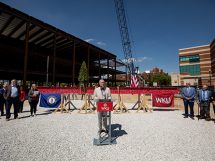FRANKFORT, Ky. (Feb. 19, 2018) — The Kentucky Equine Education Project staged its second KEEP Day in Frankfort, with horsemen and horse enthusiasts of all breeds and disciplines interacting with state legislators to discuss the economic importance of equines in their home districts.
A prevalent message: Kentucky didn’t become the Horse Capital of the World by being a one-trick pony. Horses of all types contribute significant assets to local economies and have a valuable impact on the quality of life all across the commonwealth.
“The impact of our breeds on our local economy is underestimated. We have folks in this state who are breeding and exhibiting horses. They’re spending money on feed, spending money employing help in the barns and trainers. They’re spending money on hay for horses, bedding horses, with fencing suppliers,” said Sharon Ohler of the Kentucky Paint Horse Club, referencing the three-day Paint-O-Rama show in April at Frankfort’s Lakeside Arena that is one of the breed’s largest in the world. “And when we have an event like the one coming up, we’re bringing 200-300 people into this area. We’re going to dine in the local restaurants, pump trucks full of fuel and stay at local hotels.”
“There are thousands of horses in the state who will never run on a racetrack but whose owners pump thousands of dollars into the economy.”
Horses of all breeds form a $4 billion industry in the commonwealth, supporting an estimated 100,000 in direct and indirect jobs and spanning all 120 counties. Kentucky is home to 35,000 operations with at least one horse, totaling 242,400 equines and $23.4 billion when including related assets, according to a University of Kentucky Department of Agriculture survey.
Elisabeth Jensen, KEEP’s executive vice president, called KEEP Day “a great opportunity for us to connect the dots” for legislators, with 20 Kentucky representatives and senators coming by the casual two-hour event.
“I was very pleased that so many individuals from throughout the horse industry in Kentucky – the Quarter Horse industry, Arabian, Paint Horse, the Hackney ponies, different breeds and associations – had an opportunity to interact with legislators who might not have realized that they had horses and horse businesses in their district,” she said.
Jensen said important connections come out of KEEP Day. She cited Horse Country executive director Anne Hardy meeting with Regina Stivers, the deputy secretary of the Tourism, Arts and Heritage Cabinet. Horse Country is an initiative that makes tours at breeding farms and prominent equine facilities readily accessible to the public.
“They talked a lot about the tourism opportunities for the horse industry,” Jensen said.
Those participating in other breeds also expressed appreciation for how Thoroughbred racing helps the larger horse industry. That includes the Kentucky Horse Breeders’ Incentive Fund that provides award money for 11 non-racing breeds, made all the more important with some breeds’ decreasing numbers. The KHBIF is funded by a percentage of the sales tax on the stud fee when a mare is bred to a Kentucky stallion, with Thoroughbreds overwhelmingly financing the program. The incentive awards for horses residing in Kentucky are earned through shows and contests in the state.
“It’s the only breeding fund in the country to include non-race breeds,” said Senate Majority Floor Leader Damon Thayer of Georgetown, who spearheaded the enabling legislation for the KHBIF. “If Kentucky is going to remain the Horse Capital of the world, we need to think beyond the racing breeds because they have an economic impact on their local communities in every county across the state. This is a way, through competition, for breeders’ incentive funds to be earned. And I’m glad to see the fund is alive and well and helping some of these breeds remain viable.”
Rep. James Kay of Versailles said it was important for his colleagues to understand the extent of the equine industry and that it involves much more than racing.
“When you expose the entire world of the horse industry, all the different breeds and many different jobs it creates, it gives the people a new reason to be supportive,” he said.
Rep. Phillip Pratt, whose district includes parts of Fayette, Owen and Scott counties, noted the horse industry’s broad reach, using the example of businesses not directly involved in horse racing that depend on work and services provided to Keeneland.
“It leaves a large economic foot print, without a doubt,” Pratt said. “We need to make sure it stays here in Kentucky.”
Norm Luba of the Kentucky Quarter Horse Association said he appreciated the opportunity to meet with lawmakers, including those who might not have realized the massive number of horses in the state. There are about 45,000 Quarter Horses in Kentucky, according to the UK survey.
“KEEP continues to represent the interests of owners of many breeds of horses important to the health of the horse industry in Kentucky,” Luba said. “Those of us who are Quarter Horse enthusiasts appreciate members of the Kentucky Legislature recognizing the contributions the horse industry makes to economic development within our Commonwealth.”
Eric Hamelback, chief executive officer of the National Horsemen’s Benevolent & Protective Association that represents Thoroughbred owners and trainers across the country and Canada, said Kentucky is the beacon for other states when it comes to the horse industry.
“Kentucky is the shining example of what can be accomplished when horsemen, racetracks and other equine organizations and the legislature work together. So much of the Thoroughbred industry in the Commonwealth appreciates other horse breeds and understands that helping them is in everybody’s best interest,” said Hamelback, who lives in Bourbon County. “KEEP and the various breeding funds we have that are assisted by Thoroughbred racing and breeding demonstrate that we’re all better working together. Not every district has a racetrack. But every district in Kentucky has horses.”




















Add Comment